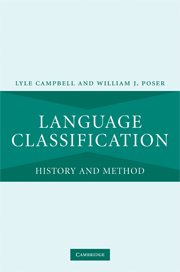Book contents
- Frontmatter
- Contents
- List of figures, tables, and charts
- Acknowledgments
- Preface
- 1 Introduction: how are languages shown to be related to one another?
- 2 The beginning of comparative linguistics
- 3 “Asiatic Jones, Oriental Jones”: Sir William Jones’ role in the raise of comparative linguistics
- 4 Consolidation of comparative linguistics
- 5 How some languages were shown to belong to Indo-European
- 6 Comparative linguistics of other language families and regions
- 7 How to show languages are related: the methods
- 8 The philosophical–psychological– typological–evolutionary approach to language relationships
- 9 Assessment of proposed distant genetic relationships
- 10 Beyond the comparative method?
- 11 Why and how do languages diversify and spread?
- 12 What can we learn about the earliest human language by comparing languages known today?
- 13 Conclusions: anticipating the future
- Appendix: Hypothesized distant genetic relationships
- References
- Index
1 - Introduction: how are languages shown to be related to one another?
Published online by Cambridge University Press: 22 September 2009
- Frontmatter
- Contents
- List of figures, tables, and charts
- Acknowledgments
- Preface
- 1 Introduction: how are languages shown to be related to one another?
- 2 The beginning of comparative linguistics
- 3 “Asiatic Jones, Oriental Jones”: Sir William Jones’ role in the raise of comparative linguistics
- 4 Consolidation of comparative linguistics
- 5 How some languages were shown to belong to Indo-European
- 6 Comparative linguistics of other language families and regions
- 7 How to show languages are related: the methods
- 8 The philosophical–psychological– typological–evolutionary approach to language relationships
- 9 Assessment of proposed distant genetic relationships
- 10 Beyond the comparative method?
- 11 Why and how do languages diversify and spread?
- 12 What can we learn about the earliest human language by comparing languages known today?
- 13 Conclusions: anticipating the future
- Appendix: Hypothesized distant genetic relationships
- References
- Index
Summary
I fear great evil from vast opposition in opinion on all subjects of classification.
(Charles Darwin 1838 [Bowlby 1990:225])Introduction
How are languages shown to be related to one another? How are language families established? Judging from media attention, it might be thought that this is one of the “hottest” questions in contemporary linguistics. Proposals of distant linguistic kinship such as Amerind, Nostratic, Eurasiatic, and Proto-World have been featured in Atlantic Monthly, Nature, Science, Scientific American, US News and World Report, The New York Times, and in BBC and PBS television documentaries. Nevertheless, these same proposals have been rejected by the majority of practicing historical linguists. The difference of opinion is reflected in much debate and considerable confusion about the methods for demonstrating family (phylogenetic) relationships among languages as yet not known to be related, and about the ways that language families have come to be established. Some enthusiasts of long-range linguistic relationships, disappointed that proposed language connections they favor have not been accepted in the profession, have at times responded bitterly. For example, we read charges that these rejections are just “clumsy and dishonest attempts to discredit deep reconstructions [proposed macro-families]” (Shevoroshkin 1989a:7, also 1989b:4).
- Type
- Chapter
- Information
- Language ClassificationHistory and Method, pp. 1 - 12Publisher: Cambridge University PressPrint publication year: 2008



